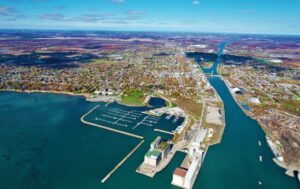Federal budget released, first since 2019
On Monday, the 2021 Federal Budget: A Recovery Plan for Jobs, Growth, and Resilience was released. The spending announced focuses on the transition from emergency response to recovery, with particular attention given to the environment, the workforce, equality in the economy, and childcare. There will be more than $101 billion in net new spending over the next three years, with $30 billion to be spent over the next five years to build a national childcare system.
Highlights that are aimed directly at individuals include: extending COVID-19 emergency benefits, EI reform, a new luxury tax, an empty-homes tax for foreign homeowners, taxes on cigarettes and vaping products, and a $15/hour federal minimum wage.
For more on the 2021 Federal Budget see: Budget 2021
The Emily Project – providing safety for rural property owners
Back in 2014, Emily Trudeau died at the age of seven in Hastings County due to a farming accident. Emily’s passing was a result of first responders’ inability to quickly get to her due to a lack of address signage. The incident led to the creation of the Emily Project.
Pelham, Wainfleet, Grimsby, and now Port Colborne have created a yellow and black Farm 911 sign system for rural lands, in line with the project. Having address signage that is easily identifiable is incredibly important to help mitigate the impact of any future emergencies.
A submission of an online application ($155) through each city’s website is needed for rural property owners to obtain a Farm 911 address sign.
Apartment project in Niagara Falls is a promising start for rental unit backlog
As housing prices continue to increase, many individuals in Niagara have struggled to find affordable housing and available rental units. At the end of 2019, more than 6,100 individuals within the region were on a centralized wait list for affordable housing. Wait times for these apartments can extend 11 to 16 years.
Niagara Falls’ population is expected to increase by 35,000 over the next 20 years. It’s clear that the direction of housing must shift to address current and future housing demands. Panoramic Properties, new apartment buildings off of Dorchester Road, south of Lundy’s Lane, will house 154 one-, two-, and three-bed units. This six-year, $40 million project will be critical for addressing apartment vacancy rates that currently reside at 0%-0.9% within Niagara Falls.
Eighty-six per cent of purpose-built rental units in Ontario were built before 1980, so Angelo Butera Sr. and Jr. – the father-son pair responsible for building Panoramic Properties – plan to build several more apartment projects in the region, including: a 140-unit building in Welland, an 86-unit building on Dorchester Road, a 350-unit building at McLeod Road and Montrose Road, as well as a 400-unit building at McLeod and Kalar roads in Niagara Falls.
Six long-term care homes in Niagara receive funds from provincial and federal governments
The provincial and federal governments are allocating $7 million to be split among six long-term-care homes in Niagara to improve air quality. The funds will be provided for alterations or the installation of heating, ventilation and air-conditioning systems, along with retrofits or repairs to fire sprinkler systems. The six long-term-care homes that will split the funds are: the Salvation Army Eventide Home, Niagara Falls (federal – $132,106, provincial – $33,207); Albright Gardens, Beamsville (federal – $3.6 million, provincial – $900,000); Shalom Manor, Grimsby (federal – $109,228, provincial – $27,307); United Mennonite Home, Vineland (federal – $1.4 million, provincial – $342,510); Tabor Manor, St. Catharines (federal – $40,400, provincial – $10,100) and Heidehof Home, St. Catharines (federal – $320,000, provincial – $80,000).
These funds are part of a $100-million investment that the Ford government is putting into 95 long-term-care homes across the province to reverse decades of underfunding and neglect. The federal-provincial governments are investing up to $1.05 billion to address health and safety related projects in long-term care, education and municipalities through the COVID-19 Resilience Infrastructure Stream of the Investing in Canada Infrastructure Program. Not only does this address the infrastructure needs for long-term-care residents, families, and staff, this investment supports local businesses and supplies and creates hundreds of jobs for local construction workers.
$44.5M needed for new south Niagara hospital, Niagara Health looks to Region for help
A new hospital is expected in Niagara at the intersection of Montrose and Biggar roads in southwest Niagara Falls. The hospital will be 1.2 million square feet and cost at least $1 billion. Niagara Health is looking to the Niagara Region for help with $44.5 million of the cost, which would be included in the community’s share of $212 million.
The new facility will be the first WELL-certified health-care facility in Canada. WELL is an international designation for plans that improve work-life experience and promote staff and physicians well-being. There will be several new and expanded regional services, including complex care, wellness and aging, stroke, and geriatric psychiatry. There will also be an Indigenous healing centre with a garden.
Canada-US land border remains closed for another month
Non-essential travel continues to be prohibited at the Canada-US land borders for at least another month. Border restrictions were first put in place in March 2020, and the border has continued to be closed as COVID-19 continues to spread. Both sides of the border have agreed to keep the measures that are in place until at least May 21, as cases (and variants) continue to rise.
COVID-19 leads Niagara Health to add more ICU beds for second time in just over a week
Niagara Health’s Critical Care capacity is in a state of crisis. Last week Niagara Health added three ICU beds to the local hospital system, bringing the total of beds to 63. This week more beds are being added as there are 71 COVID-19 patients in Niagara hospitals, with 17 of those individuals in the ICU.
At the St. Catharines hospital, the overall ICU capacity is at 104%, with the Level 3 ICU (highest level of ICU care) capacity at 164%, and ICU-vented bed capacity at 125%.
In Ontario, there are 790 individuals in the ICU due to COVID-19 related illnesses, and 32 new deaths linked to COVID-19. Hospitalization decreased by 25%, however 17 more individuals were admitted to the ICU, with 29 more requiring a ventilator.
Paid-sick leave to come for Ontario essential workers
After much backlash related to the Ontario government’s tighter restrictions for COVID-19 control last week, adjustments have continued to take place. Within the next few days, Premier Doug Ford will announce a paid sick-leave program for essential workers. While public health experts, labour groups and local officials have been fighting for months to achieve sick-leave support to help combat COVID-19, the Ontario government was waiting for federal budget alteration to make this possible. Now that there is more support from the federal government, Ontario can address issues such as eligibility, reducing wait times for receiving funds, the amount of funding available, and time off to get vaccinated.
COVID-19 Weekly Update
Niagara continues to see high COVID-19 case numbers, even though restrictions have tightened as part of the third-wave lockdown. There are 2,020 active cases as of April 21, 199 new cases, 26 new resolved cases, and two new deaths. The majority of confirmed cases have been due to contact with confirmed cases (65.9%), through community transmission (21.6%), through unknown contact/transmission (10.0%), and through travel related transmission (2.5%).
There have been 19 confirmed U.K. variants, with 1,645 variants detected on screening and 1,664 total variant cases.
St. Catharines has the most COVID-19 cases, with 540, while Welland and Niagara Falls follow with 419 and 314 cases respectively. On the low end are Niagara-on-the-Lake, West Lincoln, and Wainfleet, with 51, 46, and 19 active cases respectively.
Nearly 96% of cases are isolated at home, with 3.6% of cases hospitalized, and 0.6% of cases admitted to intensive care.
There are 18 active outbreaks, with one new outbreak as of April 21 – 30.8% of regional cases are associated with these outbreaks. The majority of cases within outbreaks are in LTC/Retirement homes (17.7%), communities (8.1%), hospitals (3.6%), and communal/congregate living (1.4%).
Just shy of 143,000 doses of vaccine have been administered to Niagara residents, with close to 30% of the local population having received at least one dose.





















